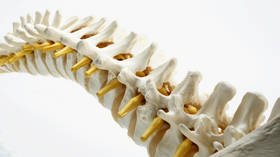‘We have a hint… it may be possible’: Controversial stem cell therapy repaired injured spinal cords in 13 patients

Using a somewhat controversial stem cell therapy, a joint team of Japanese and US-based researchers have successfully repaired some damage in 13 patients with spinal cord injuries (SCI).
SCIs can often cause permanent loss of movement and physical sensation from resultant nerve damage. While physical rehabilitation programs can partially improve outcomes, actual treatment and recovery of lost mobility and function is nigh on impossible. Until now, perhaps.
According to new results from a phase 2 clinical trial conducted in an experimental collaboration by scientists in Japan and the US, patients treated with an intravenous infusion of their own mesenchymal stem cells (MSCs), harvested from their bone marrow, saw significant functional improvements.
Also on rt.com ‘Neither robot nor animal’: Scientists develop the ‘Xenobots,’ 1st robots constructed completely from LIVING CELLS (VIDEO)MSCs are adult stem cells with the uncanny ability to morph into numerous different cell types, affording them the ability to repair different tissues in the human body, ranging from bone and cartilage to muscle or other tissues.
In 2018, Japan fast-tracked commercial approval of the treatment, opting to forego full testing and regulatory approval despite a lack of complete data on its safety and efficacy. This was much to the consternation of the medical industry at large, and caused considerable controversy in the process.
Fast-forward to the present day and the therapy, called Stemirac, may prove revolutionary in treating non-penetrative SCIs, in which the spinal cord is damaged but remains intact.
In the trials, all 13 patients demonstrated improvements in sensory and motor function six months after they received their infusion, while more than 50 percent of the participants saw substantial improvements in motor function, including walking within a day, though for others it took weeks.
Also on rt.com Researchers claim diabetes breakthrough after curing mice using stem cells"The idea that we may be able to restore function after injury to the brain and spinal cord using the patient's own stem cells has intrigued us for years," explains neurologist Stephen Waxman from Yale University, a senior author of the study.
"Now we have a hint, in humans, that it may be possible."
Other research has examined the efficacy of injected MSCs to treat SCI, but this new method involves intravenous infusion, which operates in a different way and, so far, has no adverse effects. Still, the researchers acknowledge the limited scope of the trial, as well as the fact that it was unblinded and uncontrolled.
"Importantly, intravenously infused MSCs may affect not only the injury site, but other parts of the central nervous system including brain and blood vessels," the authors explain in their paper.
For now, they suspect the stem cells secrete neural growth factors, particularly brain-derived neurotrophic factor (BDNF), which have a restorative as well as anti-inflammatory effect. While a lot more research is needed to determine the long term safety and efficacy of the treatment, it could one day prove revolutionary.
Think your friends would be interested? Share this story!













